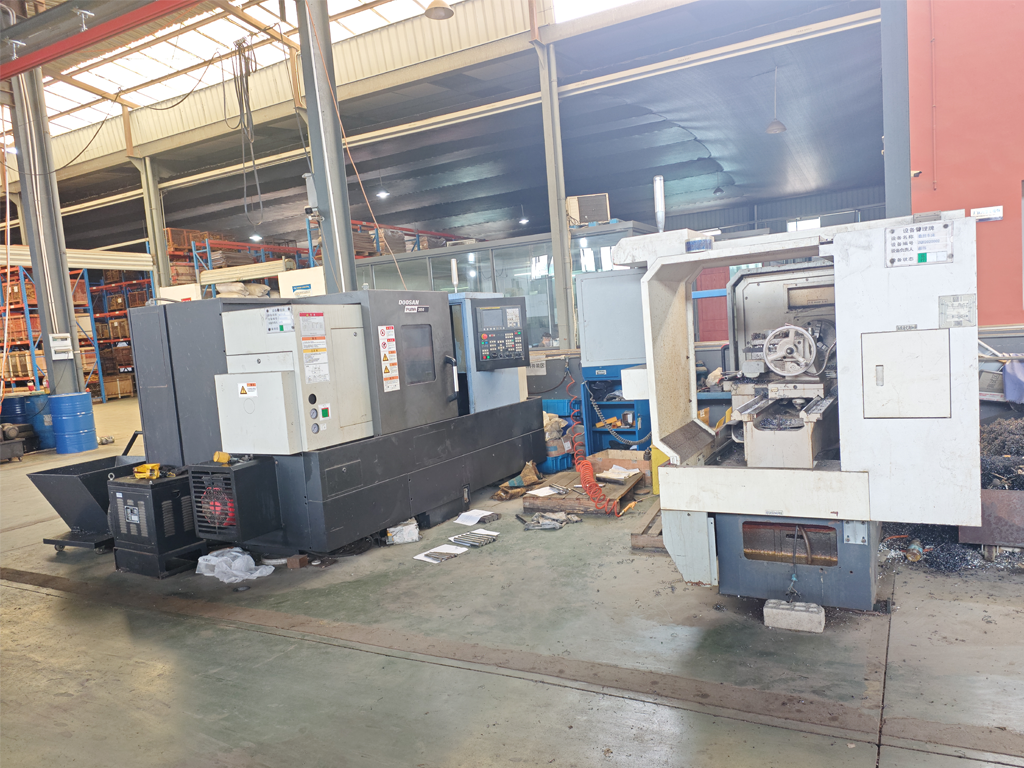CNC 가공
1.정의
CNC (컴퓨터 수치 제어) 가공은 컴퓨터 제어 시스템을 사용하여 절삭 도구를 세 축에서 다섯 축까지 이동시키는 매우 정확한 전기 기계식 프로세스입니다. 과도한 재료를 정확히 제거하여 원자재를 높은 정확도로 완제품으로 가공합니다. 이 프로세스는 CAD (컴퓨터 지원 설계) 모델로 시작되며, 이를 실시간으로 머신의 움직임을 안내하는 CNC 프로그래밍 코드로 변환합니다.
CNC 가공은 수직 및 수평 가공 기술을 모두 사용하여 회전 및 밀링 부품에 대해 탁월한 품질을 보장합니다. 이는 높은 정밀도와 효율성을 요구하는 산업에서 널리 적용됩니다.
2.역사
최초의 컴퓨터 수치 제어 기계는 1940년대와 1950년대에 기존 도구에 모터를 장착하여 구멍 난 테이프에 인코딩된 명령에 따라 도구나 작업물을 이동하도록 개발되었습니다. 이러한 초기 서보 제어 시스템은 곧 아날로그 및 디지털 컴퓨터로 강화되어 현대의 CNC 머신이 탄생하게 되었으며, 이는 전 세계의 가공 공정을 변화시켰습니다.
3.공정
디지털 설계 (CAD)
CNC 공정은 CAD 소프트웨어를 사용하여 정확한 2D 또는 3D 모델을 생성하며, 부품의 기하학, 허용오차 및 치수를 정의합니다.
CAM 프로그래밍
CAD 모델은 CAM 소프트웨어로 가져와져 최적화된 도구 경로를 생성하고 설계를 CNC 실행을 위한 머신 읽을 수 있는 코드로 변환합니다.
CNC 머신 설정
작업자는 적절한 절삭 도구를 설치하고 도구 오프셋을 정의하며 냉각제 및 윤활 시스템을 준비합니다. 도구 교체는 수동으로 또는 자동 도구 교환기(ATC)를 통해 관리됩니다.
작업물 고정
맞춤 고정장치, 집게 또는 콜렛은 공작물을 안전하게 고정하여 가공 중 안정성, 정확성 및 반복성을 보장합니다.
프로그램 로딩
G-code는 USB, Ethernet 또는 컨트롤 패널을 통해 CNC 머신으로 전송됩니다. 일부 코드는 간단한 작업을 위해 수동으로 작성되거나 대화식 인터페이스를 통해 생성됩니다.
프루핑 & 시뮬레이션
'드라이런' 또는 소프트웨어 기반 시뮬레이션이 생산이 시작되기 전에 프로그램의 오류, 충돌 및 툴패스 정확성을 확인합니다.
부품 가공
CNC 머신은 밀링, 터닝, 드릴링 및 탭핑 작업을 실행합니다. 대량 생산 전 첫 번째 제품은 CAD 모델과 비교하여 정확성을 확인합니다.
품질 보증
진행 중인 검사, 자동 측정 시스템 및 표면 마감 검사가 사양에 부합하는 일관성을 보장합니다. 

4.응용
CNC 가공은 자동차, 철도, 건설 기계, 채굴 장비, 물류 및 농업을 포함한 다양한 산업에서 널리 사용됩니다. 그 이유는 높은 정밀도, 반복성, 그리고 좁은 허용 범위 내에서 복잡한 설계를 처리할 수 있는 능력 때문입니다.
5.CNC 가공의 유형
CNC 터닝 (라테)
회전하는 공작물을 고정된 공구에 대비시켜 실린더형, 원추형 또는 구형 가공물 제작에 적합하며 샤프트, 부싱 및 나사 부품 가공에 이상적입니다.
CNC 밀링
3+ 축에서 회전식 다중 점 커터를 사용하여 포켓팅, 페이싱, 슬롯팅, 카운터싱크 및 보링과 같은 다양한 작업을 수행합니다. 복잡한 표면과 정밀 부품을 처리합니다.
CNC 뚫기
정확한 구멍을 자동으로 드릴링하며, 고급 머신은 각도별 및 복합 드릴링 패턴을 지원합니다.
CNC 연마
마모성 휠을 사용하여 좁은 허용 범위와 매끄러운 표면을 얻는 마무리 공정으로, 대개 조립 전에 사용됩니다.
Cnc 레이저 절단
금속, 플라스틱, 목재 및 복합 재료에서 복잡한 형태를 위한 초점 레이저를 사용한 비접촉 절단. 열 영향이 적고 빠릅니다.
CNC 플라즈마 절단
이온화된 가스를 사용하여 전도성 금속을 깨끗하고 정확한 가장자리로 절단합니다. 큰 크기와 두꺼운 강철 부품에 적합합니다.
Cnc 라우터
목재, 플라스틱, 폼 및 연한 금속에 이상적입니다; 상세 조각, 간판 제작, 가구 제작 및 예술 작업에서 뛰어납니다.
다섯 축 CNC 가공
전통적인 3축 가공에 두 개의 회전 축을 추가하여 단일 설정에서 복잡하고 다방향으로 절삭할 수 있도록 합니다. 항공우주, 의료 및 고정밀 사출 성형에 필수적입니다.
워터젯 절단
고압 물에 마모성 물질을 혼합하여 열 손상 없이 거의 모든 재료를 절단합니다. 열에 민감하거나 복합 재료에 완벽합니다.
6.자주 묻는 질문
1) CNC 머신ning이란 무엇인가요?
CNC 머신닝은 컴퓨터 소프트웨어가 사전 프로그래밍되어 기계 도구의 움직임을 제어하여 재료를 정확한 부품으로 절단하고 모양을 만드는 제조 공정입니다.
2) CNC 머신닝과 수동 머신닝은 어떻게 다릅니까?
수동 머신닝과 달리 CNC 머신닝은 컴퓨터 프로그램(G-code)에 의해 안내되는 완전 자동화된 과정으로 정확성, 반복 가능성 및 효율성을 향상시킵니다.
3) G-code란 무엇입니까?
G-code는 CNC 머신을 제어하기 위해 사용되는 프로그래밍 언어로, 가공 작업의 공구 경로, 속도 및 피드율을 지정합니다.
4) CNC 프로그램은 어떻게 생성됩니까?
프로그램은 CAM(컴퓨터 지원 제조) 소프트웨어를 사용하여 CAD(컴퓨터 보조 설계) 모델을 기계 코드로 변환하여 생성됩니다.
5) 어떤 산업에서 CNC 가공을 일반적으로 사용합니까?
항공우주, 자동차, 의료, 전자, 채굴, 건설 등의 산업은 CNC 가공에 크게 의존합니다.
6) CNC 가공에는 어떤 안전 조치가 포함됩니까?
안전 조치에는 올바른 프로그래밍, 기계 유지보수, 냉각제 사용, 운영자 교육 및 이동 부품의 가드 설치가 포함됩니다.